产品版本发布说明书 模板
版本发布审核模板
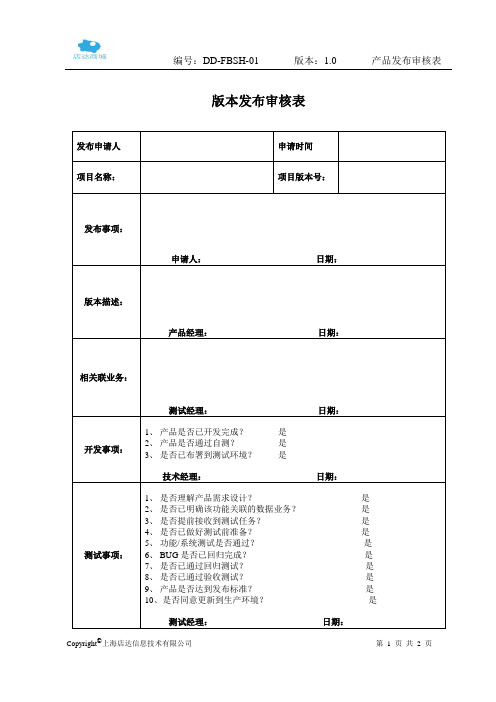
版本发布审核表
发布申请人申请时间
项目名称:项目版本号:
发布事项:
申请人:日期:版本描述:
产品经理:日期:相关联业务:
测试经理:日期:
开发事项:1、产品是否已开发完成?是
2、产品是否通过自测?是
3、是否已布署到测试环境?是
技术经理:日期:
测试事项:1、是否理解产品需求设计?是
2、是否已明确该功能关联的数据业务?是
3、是否提前接收到测试任务?是
4、是否已做好测试前准备?是
5、功能/系统测试是否通过?是
6、BUG是否已回归完成?是
7、是否已通过回归测试?是
8、是否已通过验收测试?是
9、产品是否达到发布标准?是
10、是否同意更新到生产环境?是
测试经理:日期:
测试结果:1、不存在高级别以上的BUG。
2、所有BUG均已关闭。
结论:所有提交的BUG均已回归,经多轮测试暂无发现影响功能性正常使用的BUG,已通过验收测试并可正式发布到生产环境。
测试经理:日期:
风险告知:
无
对接人:
技术经理确认:确认时间:产品经理确认:确认时间:测试经理确认:确认时间:CTO审核:确认时间:。
产品技术要求模板

医疗器械产品技术要求编号:医学影像处理软件120XX-XX-XX发布20XX-XX-XX实施成都数浪信息科技有限公司2医疗器械产品技术要求编号:医学影像通讯与存储系统1 产品型号规格及其划分说明1.1 软件型号规格XX1.2 发布版本产品发布版本:V1.0产品完整版本:V1.0.01.3 版本命名规则本公司软件产品命名规则为V X.Y.Z•X:为发行版本,表示重大增强类软件更新,初始值为1,当软件进行了重大增强类软件更新,该号码加1,Y和Z归0。
•Y:为子版本号,表示轻微增强类软件更新,初始值为0,当软件进行了轻微增强类软件更新,该号码加1,Z归0。
•Z:为修正版本号,表示纠正类软件更新,初始值为0,当软件进行了纠正类软件更新,该号码加1。
1.4 产品适用范围产品用于人体诊查图像、数据的管理、查看、传输和贮存,不包括自动诊断部分。
2 性能指标2.1 通用要求2.1.1 处理对象3针对医学影像(包括核磁、CT、超声、X光机、胃肠机、CR、DR、乳腺机、PET、DSA、牙片机、彩色多普勒超声、内窥镜、阴道镜、耳鼻喉镜、胃镜、肠镜等设备产生的图像)进行处理。
2.1.2 最大并发数系统运行的网络环境在100M/1000M局域网情况下,支持并发读取影像数据的最大用户数为50。
2.1.3 数据接口产品通过DICOM标准接口与医疗设备进行影像传输,支持通过标准HL7或数据库接口与第三方系统交互,支持模拟视频信号接口。
2.1.4 特定软硬件所需软件环境最低配置如下:4模块功能菜单子菜单描述备注UniwebViewer 功能按钮【上一个检查】快速打开上一个病人的检查影像。
【下一个检查】快速开启下一个病人的检查影像。
【窗口靠左半部显示】实现UniWeb Viewer视窗靠左半边显示。
【窗口靠右半部显示】实现UniWeb Viewer窗口靠右半边显示。
【窗口靠上半部显示】实现UniWeb Viewer视窗靠上半边显示。
山石云·格版本说明说明书

Version2.7.5TechDocs|版本说明《版本说明》包含了云·格2.6.2版本以及后续版本的版本说明,主要介绍了各版本的新增功能、已解决问题及已知问题等内容。
l v2.6.2l v2.6.2l v2.6.2.1l v2.6.2.3l v2.6.2.4l v2.6.2.6l v2.6.2.8l v2.6.2.9l v2.6.2.11l v2.6.2.12l v2.6.2.13l v2.7l v2.7l v2.7.0.2l v2.7.0.3l v2.7.1l v2.7.1l v2.7.2l v2.7.2l v2.7.3l v2.7.3l v2.7.3.1l v2.7.4l v2.7.5v2.6.2版本升级说明若需升级,请对照您的现有版本和目标版本,参考以下升级说明:系统要求VMware基础平台l CloudHive版本可部署于VMware vSphere5.5、6.0、6.5和6.7。
l各虚拟机模块资源规格要求如下:o vSOM虚拟机需要2个vCPU、2GB内存和12GB硬盘。
说明:当云•格管理资源大于64个物理服务器时,建议扩展vSOM的vCPU和内存规格以提高处理效率。
vCPU最大可扩展至4个,内存最大可扩展至8GB。
o vSCM虚拟机需要2个vCPU、6.5GB内存和17GB硬盘。
o vSSM虚拟机目前支持两种规格:vSSM-02和vSSM-04。
vSSM-02虚拟机需要2个vCPU、4GB内存(开启Jumbo Frame时,需要6G内存)和5GB硬盘。
vSSM-04虚拟机需要4个vCPU、8GB内存(开启Jumbo Frame时,需要10G内存)和5GB硬盘。
o vDSM虚拟机需要2个vCPU、4GB内存和5GB硬盘。
l需要提前预留1~5个全局VLAN ID,并把每台主机的数据接口连接的交换机接口都配置成可透传预留的全局VLAN ID的Trunk模式。
VMware NSX平台l已经安装VMware vCenter、VMware vSphere和VMware NSX(需用户自行购买),版本要求如下:o VMware vCenter:6.0、6.5和6.7o VMware ESXi:5.5、6.0、6.5和6.7o VMware NSX:6.2.x、6.3.x和6.4.x说明:要使云•格达到较高性能,需同时满足以下版本要求:o VMware vCenter:6.0Update2及以上、6.5或6.7o VMware ESXi:6.0Update2及以上、6.5或6.7o VMware NSX:6.3.2及以上或6.4.xl各虚拟机模块资源规格要求如下:o vSOM虚拟机需要2个vCPU、2GB内存和12GB硬盘。
产品说明书模板免费下载
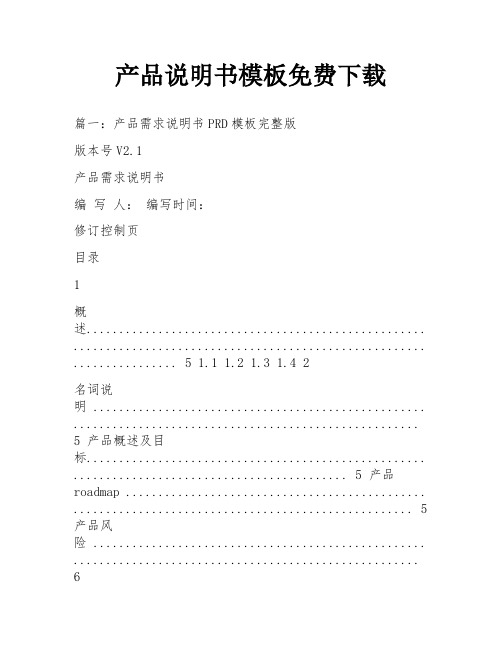
产品说明书模板免费下载篇一:产品需求说明书PRD模板完整版版本号V2.1产品需求说明书编写人:编写时间:修订控制页目录1概述.................................................... ...................................................... ................ 5 1.1 1.2 1.3 1.4 2名词说明 ................................................... .....................................................5 产品概述及目标.................................................... .......................................... 5 产品roadmap .............................................. . (5)产品风险 ................................................... .. (6)使用者需求 ................................................... ...................................................... ...... 6 2.1需求描述 ................................................... .. (6)3 4可选方案.................................................... ...................................................... ......... 6 效益成本分析.................................................... ...................................................... .. 7 4.1 4.2 4.3效益预测 ................................................... .....................................................7 产品技术中心成本 ................................................... ....................................... 7 非产品技术中心的支持成本 ................................................... . (8)5 功能需求............................................................. 8 5.1 5.2 5.3 5.4功能总览 ................................................... .....................................................8 功能详情 ................................................... (12)整合需求 ................................................... (13)BETA测试需求 ................................................... .. (13)6 非功能需求 ................................................... ...................................................... .... 14 产品营销需求.................................................... ................................................... 1414 规则变更需求.................................................... ......................................................14 产品服务需求.................................................... ......................................................14 法务需求.................................................... ...................................................... ....... 15 财务需...................................................... ....... 15 帮助需求.................................................... ...................................................... ....... 15 安全性需求 ................................................... ...................................................... . (15)7 上、下线需求.................................................... ......................................................15 7.1 7.2上线时限需求 ................................................... ............................................ 15 下线需求(活动类需求必须明确下线时间).. (15)8运营计划.................................................... ...................................................... . (15)请与以下部门讨论PRD序号 1.XXX □部门市场部: XXX3.□技术支持部:? 客服服务 ? XXX4.□技术支持部: 网络安全沟通内容协助设定产品的RaodMap 协助设定target customer:使用者协助评估:营销/推广需求协助设定商业目标协助设定产品的RaodMap 协助设定target customer:使用者协助评估:营销/推广需求协助设定商业目标讨论客服如何支持:客服需求协助评估诈欺/数据窜改风险:欺诈/数据窜改风险、不当使用风险预测客服成本、工作量评估安全性2. □ 销售部: XXX5. □XXX技术研发部: ? 系统分析师 ? ? ?技术研发部: ? 项目经理 ? XXX XXX 产品部:用户体验设计之交互设计师讨论以确定方案的规模评估、推出计划进行技术可行性分析,提出关键问题的技术解决方案评估系统规模,数据量,所需资源等协助评估风险协助确定产品发布日期协助确定产品成本协助评估风险协助制作Demo协助确定 use flow:用户使用方式协助确定UI UE的方向风格6. □7. □8. □XXX财务分析中心:财务组请评估财务需求协助评估风险9. 10.□ □XXX数据分析组: XXX行政管理中心:法务部 XXX协助确定如何度量产品目标协助评估法务问题并检视合作伙伴:使用者数据需求、法务需求、版权、隐私权等需求协助评估风险:诈欺/数据窜改风险、不当使用风险1 概述1.1 名词说明1.2 产品概述及目标1.3 产品roadmap请描述产品发展的各个阶段,可以用图表等多种方式表述。
产品说明书格式范文怎么写的
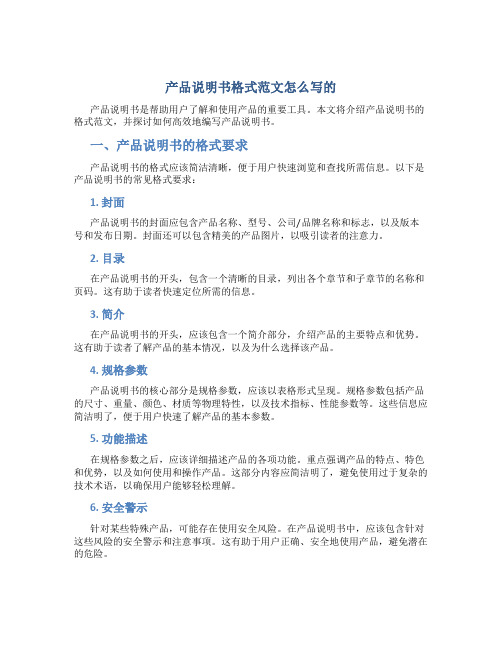
产品说明书格式范文怎么写的产品说明书是帮助用户了解和使用产品的重要工具。
本文将介绍产品说明书的格式范文,并探讨如何高效地编写产品说明书。
一、产品说明书的格式要求产品说明书的格式应该简洁清晰,便于用户快速浏览和查找所需信息。
以下是产品说明书的常见格式要求:1. 封面产品说明书的封面应包含产品名称、型号、公司/品牌名称和标志,以及版本号和发布日期。
封面还可以包含精美的产品图片,以吸引读者的注意力。
2. 目录在产品说明书的开头,包含一个清晰的目录,列出各个章节和子章节的名称和页码。
这有助于读者快速定位所需的信息。
3. 简介在产品说明书的开头,应该包含一个简介部分,介绍产品的主要特点和优势。
这有助于读者了解产品的基本情况,以及为什么选择该产品。
4. 规格参数产品说明书的核心部分是规格参数,应该以表格形式呈现。
规格参数包括产品的尺寸、重量、颜色、材质等物理特性,以及技术指标、性能参数等。
这些信息应简洁明了,便于用户快速了解产品的基本参数。
5. 功能描述在规格参数之后,应该详细描述产品的各项功能。
重点强调产品的特点、特色和优势,以及如何使用和操作产品。
这部分内容应简洁明了,避免使用过于复杂的技术术语,以确保用户能够轻松理解。
6. 安全警示针对某些特殊产品,可能存在使用安全风险。
在产品说明书中,应该包含针对这些风险的安全警示和注意事项。
这有助于用户正确、安全地使用产品,避免潜在的危险。
7. 使用说明产品说明书应该提供详细的使用说明,包括产品的组装、操作和维护等方面。
尽量使用图文结合的方式,例如使用步骤图、示意图等,以便用户更直观地了解产品的使用方法。
8. 常见问题解答在产品说明书的最后,可以设置一个常见问题解答的部分,列举一些用户常见的疑问和解答。
这有助于用户迅速解决一些常见问题,减少产品使用过程中的困扰。
二、如何高效编写产品说明书编写一份高质量的产品说明书需要一定的技巧和经验。
以下是一些建议,可以帮助您高效编写产品说明书:1. 理解用户需求在编写产品说明书之前,充分了解目标用户的需求和背景是关键。
产品版本发布说明书-模板V2.0.0

版本号:V2.0开
金睛数据反爬服务平台
版本发布说明书
中网数据(北京)股份有限公司
二零一七年三月
软件版本发布说明书
软件系统全称及英文全称
金睛数据反爬服务平台/GoldenEye
软件系统简称及英文简称
金睛/GOL
版本发布申请人
本次版本发布类型
□ 对内发布(发布给公司内部进行内部系统或回归测试。)
□ 对外发布(发布给市场、或客户使用)
基础版本(内部版本号)
发布时间
本次发布版本(内部版本号)
发布时间
外部版本(对外发布的版本号,与内部版本无关但是对应,一般由市场部来定义)
发布时间
新增功能说明
序号
功能需求编号
功能名称
描述
**是否通过测试
修复缺陷说明
序号
缺陷号
所属功能模块(或编号)
缺陷简要描述
**是否修正
**公司测试负责人(具体意见、签字、日期):
参考该项目的《测试报告》,见上面应提交的附件信息,给出下面的审批结论:
□测试通过
□测试基本通过,但是还需改进这些地方:
□测试不通过
负责人签字/日期:
**本项目直接负责上级(具体意见、签字、日期):
上级领导根据上面提交的所有附件的完备性,以及配置管理负责人和测试负责人的签署意见,给出最后的审批意见。
配置项最低提交物审计报告
[给出附件的正确名称,并指明在SVN中放置的具体地点]
**版本发布审批
**公司配置管理负责人(具体意见、签字、日期):
参考该项目的《配置项最低提交物审计报告》,见上面应提交的附件信息,给出下面的审批结论:
□满足最低提交物要求
产品需求说明书(PRD)模板-精简版
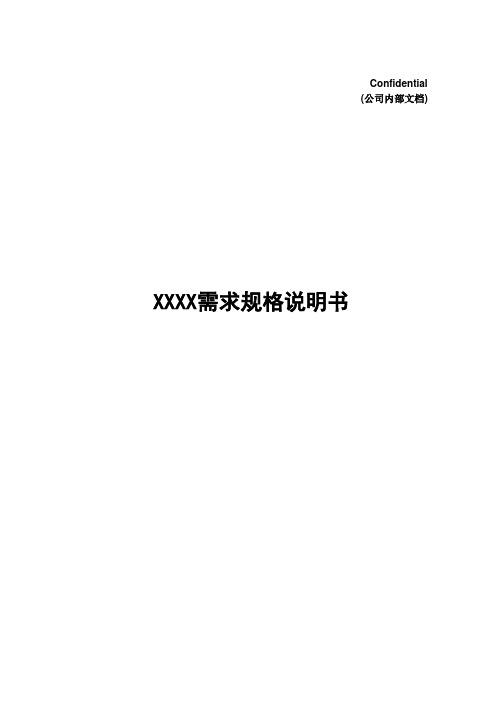
Confidential(公司内部文档)XXXX需求规格说明书需求规格说明书目录1 前言 (3)1.1编写目的 (3)1.2文档约定 (4)1.3术语和缩略词 (4)1.4参考资料 (5)2 项目概述 (5)2.1项目背景 (5)2.2项目目标 (5)2.3需求范围 (6)2.4总体框架 (6)2.5组织机构 (7)2.6用户特点 (8)2.7设计约束 (8)3 功能性需求 (9)3.1总体流程 (9)3.2角色定义 (9)3.3系统功能 (10)3.4功能描述 (10)4 非功能性需求 (14)4.1软件需求 (14)4.2硬件需求 (15)5 风险分析 (16)6 其他说明 (16)1 前言1.1 编写目的[说明编写这份需求规格说明书的目的,指出预期的读者(一般包括评审人员、软件设计人员、软件开发人员,针对具体情况,还可能包括客户),它是软件开发的基础。
]示例:1.准确全面定义、阐述xx业务需求,明确xx系统的目标和功能。
2.为有关业务部门和技术部门提供对这个系统的统一的文字的理解。
为业务部门判断系统是否满足其业务需要提供文字依据,为技术部门监督项目功能提供统一标准。
3.在xx系统之前尽可能周密考虑全部需求及设计要求,减少以后可能的重新设计、重新编码、重新测试等工作。
4.为设计项目方案、编制计划进度提供文字依据。
5.为对项目的完成进行确认和验证提供基准。
本需求规格说明书合法读者对象为:软件开发项目管理者、设计师、测试工程师、技术人员、业务人员。
1.2 文档约定[描述编写文档时所采用的字体标准或排版约定,包括标题和正文的字体和字号约定。
完成文档编写后,文档编写完成后本部分须裁剪]字体大小约定:标题1 宋体三号加粗标题2 宋体小三号加粗标题3 宋体四号加粗标题4 宋体小四号加粗标题5 宋体小四号正文宋体五号段落约定:文章中每段落需抬头,即段落开头需有两字元的缩排,单倍行距。
表与图编号约定:文中所有表、图须按章节编号,如:第四章节第二个表,编号为:表4-2。
软件发布版本说明模板

XX_ReleaseNotes发布版本说明模板Revision record修订记录Distribution List 分发记录目录历史记录.................................................... 错误!未定义书签。
目录 (1)发布版本说明:总体 (4)1 引言 (4)1.1 声明 (4)1.2 目的 (4)1.3 背景 (4)1.4 定义 (4)1.5 参考资料 (4)2 关于本发布版本 (5)3 兼容性 (5)4 安装 (5)4.1 安装文件 (5)4.2 安装步骤 (5)5 升级 (5)5.1 升级文件 (5)5.2 升级步骤 (5)6 新特性 (5)7 已知错误和局限性 (5)7.1 一般说明 (5)7.2 缺陷或错误 (5)发布版本说明:总体1引言1.1声明XXX有限公司不对此文档中的任何内容作任何明示或暗示的陈述或保证,而且不对特定目的的适销性及适用性或者任何间接、特殊或连带的损失承担任何责任。
版权所有错误!未指定书签。
,XXX有限公司保留所有权利。
“XXX有限公司”和XXX有限公司的产品名是XXX有限公司的商标。
在引用其他公司及其产品时将使用这些公司各自拥有的商标,这种使用的目的仅限于引用。
1.2目的编写发布版本说明文档的目的是要说明<项目名称>此发布版的安装、新特性和主要变更。
其中还记录了已知的问题和解决方法。
1.3背景[说明:a 系统的中英文名称b 本发布版本的版本号]1.4定义[列出文档中用到的专业术语、缩略表示及其他们的含义]1.5参考资料[列出相关参考资料的信息,如a 经核准的计划任务书或合同,上级机关的批文b 项目的其他技术文档2关于本发布版本[说明本发布版本的版本号,本发布版本具有的特征]3兼容性[在此列出已经测试过的软件、硬件或平台,同时还要说明对环境的要求] 4安装4.1安装文件[说明安装文件的构成]4.2安装步骤[一步一步说明本发布版本的安装方法]5升级5.1升级文件[说明升级文件的构成]5.2升级步骤[一步一步说明从以前的发布版本如何升级到本发布版本]6新特性[逐条列出本发布版本的新特性]1、……..2、……..……………7已知错误和局限性7.1一般说明[说明所有会影响整体功能的一般局限性]7.2缺陷或错误[逐条描述缺陷或错误,如果有解决方法,同时要给出解决方法]1、……..2、……..……………欢迎您的下载,资料仅供参考!致力为企业和个人提供合同协议,策划案计划书,学习资料等等打造全网一站式需求。
软件产品规格说明书模板

软件产品规格说明书模板一、产品概述1.1产品名称:XXX软件1.2产品版本:V1.01.3产品功能:XXX软件是一款面向XXX领域的专业XXX软件,具有XXX、XXX、XXX等丰富的功能模块,可以满足用户在XXX方面的各种需求。
1.4产品定位:XXX软件定位于为XXX领域的XXX人士提供高效、便捷、全面的XXX解决方案,帮助用户提高工作效率,降低成本,提升竞争力。
1.5产品优势:XXX软件具有以下几个方面的优势:-具备XXX领域的专业知识和经验,能够为用户提供专业化的解决方案;-丰富的功能模块,可以满足不同用户的多样化需求;-便捷的操作界面,用户友好的交互体验;-稳定可靠的软件性能,保障用户工作的顺畅进行。
1.6产品目标:XXX软件的目标是成为XXX领域的领先品牌,为用户提供最优质的XXX解决方案,成为用户信赖的长期合作伙伴。
二、产品功能2.1 XXX功能模块:- XXX模块:实现XXX功能,XXX特点;- XXX模块:实现XXX功能,XXX特点;- XXX模块:实现XXX功能,XXX特点;2.2 XXX功能模块:- XXX模块:实现XXX功能,XXX特点;- XXX模块:实现XXX功能,XXX特点;- XXX模块:实现XXX功能,XXX特点;2.3 XXX功能模块:- XXX模块:实现XXX功能,XXX特点;- XXX模块:实现XXX功能,XXX特点;2.4 XXX功能模块:- XXX模块:实现XXX功能,XXX特点;- XXX模块:实现XXX功能,XXX特点;- XXX模块:实现XXX功能,XXX特点;2.5 XXX功能模块:- XXX模块:实现XXX功能,XXX特点;- XXX模块:实现XXX功能,XXX特点;- XXX模块:实现XXX功能,XXX特点;2.6 XXX功能模块:- XXX模块:实现XXX功能,XXX特点;- XXX模块:实现XXX功能,XXX特点;三、产品技术参数3.1软件平台:支持Windows、Mac、Linux等多个操作系统平台3.2开发语言:采用XXX语言开发3.3数据库:支持XXX数据库3.4硬件环境:最低配置为XXX,推荐配置为XXX3.5软件接口:支持XXX、XXX等接口3.6网络要求:需要联网使用,支持XXX网络四、产品使用说明4.1安装说明:用户可以通过XXX方式进行安装,XXX步骤。
PRD产品需求规格说明书标准模版

系统需求规格说明书- XX系统-XX需求版本:V0.9发布日期2017年05月03日文档描述目录1引言 (5)1.1背景 (5)1.2目标 (5)1.3范围 (5)1.4干系人 (5)1.5术语缩略语 (5)1.6规范性文件 (6)2业务需求说明 (6)2.1用户说明 (6)2.2业务期望 (6)2.3业务流程 (6)2.4业务规则 (6)3功能概述 (6)3.1需求树分解 (6)3.2多系统间功能流程描述 (7)3.2.1XX系统改造描述 (8)3.2.2YY系统改造描述 (8)3.2.3AA系统改造描述 (8)3.2.4BB系统改造描述 (8)3.3接口清单 (9)4本系统需求概述 (9)4.1系统流程图 (9)4.1.1XXXX流程图 (11)4.1.2XXXX流程图 (11)4.2关键业务逻辑或算法 (11)4.3需求功能清单 (11)4.4数据字典 (12)5功能需求 (12)5.1XXX功能模块 (12)5.1.1执行者 (12)5.1.2条件说明 (12)5.1.3菜单索引 (12)5.1.4主界面原型 (12)5.1.5流程及规则说明 (13)5.1.6用例/操作说明 (13)5.1.6.1用例/操作XXX1说明 (13)5.1.6.2用例/操作XXX2说明 (14)6用户角色及权限 (14)7历史数据处理 (15)8非功能需求 (15)8.1运行环境和资源要求 (15)8.2设计和实现约束 (15)8.3性能需求 (15)8.4安全性需求 (15)8.5版本发布需求 (15)8.6质量标准需求 (15)8.7维护服务支持需求 (16)9附件列表 (16)10待确定问题列表 (16)1引言1.1背景【描述需求的背景来源、现状分析】1.2目标【描述需求实现的目的、此需求实现后带来的优势,确认目标读者】1.3范围【描述需求实现具体范围界定,涉及的业务部门及用户,解决的业务问题。
包含:业务范围界定、使用部门范围界定、系统集成范围界定等】具体对应关系见下表:1.4干系人1.5术语缩略语【描述文中涉及到的相关业务术语,行业术语、缩略语,并做简要解释】【如果没有,可以裁剪。
智铠 V5.0 版本说明说明书

版本说明
本手册包含了山石网科智铠统一终端安全管理系统所有已发布的版本说明,主要介绍了版本的系统文件、适用联动设备版本、功能列表、已知问题等内容。
l智铠5.0R1
智铠5.0R1
发布日期:2022年10月31日
该版本是山石网科智铠统一终端安全管理系统的首次发布。
山石网科智铠是面向政府、金融、医疗、教育、互联网等企事业单位推出的终端管理、等保基线检查、病毒威胁检测与响应的一体化安全防护方案,在安全能力方面集成了EPP和EDR双重安全能力,实现事前的运维管控和合规检查,事中有效抵御病毒威胁,事后追踪溯源和安全审计。
版本发布信息:https:///show_bug.cgi?id=30681
平台和系统文件
适用联动设备版本
功能列表
已知问题
浏览器兼容性
以下浏览器通过了WebUI测试,推荐用户使用:
l Chrome
l Microsoft Edge
获得帮助
山石网科智铠统一终端安全管理系统配有以下手册,请访问https://进行下载。
l《智铠统一终端安全管理系统WebUI用户手册》
l《智铠终端探针WebUI用户手册》
l《智铠统一终端安全管理系统部署手册》
服务热线:400-828-6655
官方网址:https://。
产品需求说明书(PRD)模板-精简版

Confidential(公司内部文档)XXXX需求规格说明书需求规格说明书目录1 前言 (3)1.1编写目的 (3)1.2文档约定 (4)1.3术语和缩略词 (4)1.4参考资料 (5)2 项目概述 (5)2.1项目背景 (5)2.2项目目标 (5)2.3需求范围 (6)2.4总体框架 (6)2.5组织机构 (7)2.6用户特点 (8)2.7设计约束 (8)3 功能性需求 (9)3.1总体流程 (9)3.2角色定义 (9)3.3系统功能 (10)3.4功能描述 (10)4 非功能性需求 (14)4.1软件需求 (14)4.2硬件需求 (15)5 风险分析 (16)6 其他说明 (16)1 前言1.1 编写目的[说明编写这份需求规格说明书的目的,指出预期的读者(一般包括评审人员、软件设计人员、软件开发人员,针对具体情况,还可能包括客户),它是软件开发的基础。
]示例:1.准确全面定义、阐述xx业务需求,明确xx系统的目标和功能。
2.为有关业务部门和技术部门提供对这个系统的统一的文字的理解。
为业务部门判断系统是否满足其业务需要提供文字依据,为技术部门监督项目功能提供统一标准。
3.在xx系统之前尽可能周密考虑全部需求及设计要求,减少以后可能的重新设计、重新编码、重新测试等工作。
4.为设计项目方案、编制计划进度提供文字依据。
5.为对项目的完成进行确认和验证提供基准。
本需求规格说明书合法读者对象为:软件开发项目管理者、设计师、测试工程师、技术人员、业务人员。
1.2 文档约定[描述编写文档时所采用的字体标准或排版约定,包括标题和正文的字体和字号约定。
完成文档编写后,文档编写完成后本部分须裁剪]字体大小约定:标题1 宋体三号加粗标题2 宋体小三号加粗标题3 宋体四号加粗标题4 宋体小四号加粗标题5 宋体小四号正文宋体五号段落约定:文章中每段落需抬头,即段落开头需有两字元的缩排,单倍行距。
表与图编号约定:文中所有表、图须按章节编号,如:第四章节第二个表,编号为:表4-2。
版本发布说明模板
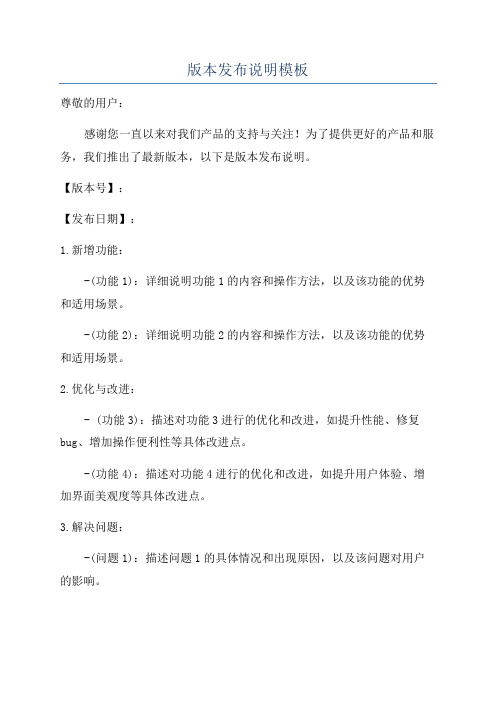
版本发布说明模板
尊敬的用户:
感谢您一直以来对我们产品的支持与关注!为了提供更好的产品和服务,我们推出了最新版本,以下是版本发布说明。
【版本号】:
【发布日期】:
1.新增功能:
-(功能1):详细说明功能1的内容和操作方法,以及该功能的优势和适用场景。
-(功能2):详细说明功能2的内容和操作方法,以及该功能的优势和适用场景。
2.优化与改进:
- (功能3):描述对功能3进行的优化和改进,如提升性能、修复bug、增加操作便利性等具体改进点。
-(功能4):描述对功能4进行的优化和改进,如提升用户体验、增加界面美观度等具体改进点。
3.解决问题:
-(问题1):描述问题1的具体情况和出现原因,以及该问题对用户的影响。
-(问题2):描述问题2的具体情况和出现原因,以及该问题对用户的影响。
我们听取了用户的反馈,并对以上问题进行了处理,确保产品的稳定性和正常运行。
4.用户体验优化:
-优化了产品界面,提升了用户操作的便利性和流畅度,使用户使用起来更加舒适和顺畅。
-增强了产品的稳定性和安全性,保障用户的数据和隐私安全。
5.其他改进:
-优化了产品的代码结构,提升了产品的性能和响应速度。
-加强了产品的兼容性,支持更多平台和设备的使用。
再次感谢您的支持和关注!我们将一如既往地努力,不断提升产品的质量和用户体验,为您带来更好的服务。
祝您使用愉快!。
版本发布说明模板

模块名称
分体机 分体机 分体机 分体机 分体机 分体机 分体机 分体机 分体机 分体机 分体机 分体机 分体机 其它机 其它机 其它机 其它机 其它机 其它机
倒车轨迹参数设置 倒车轨迹参数设置
责任人
曾敏 曾敏
更新时间
更新类型 适应机型 缺陷修复 三星所有机型 缺陷修复 三星所有机型 缺陷修复 所有机型 缺陷修复 缺陷修复 缺陷修复 缺陷修复 缺陷修复 缺陷修复 缺陷修复 缺陷修复 缺陷修复 缺陷修复 缺陷修复 程序优化 程序优化 程序优化 程序优化 程序优化 程序优化 程序优化 新增需求 新增需求 新增需求 新增需求
BUGID
程序更新信息 变更描述
增加奔驰B200、宝马320i 增加奔驰B200、宝马320i 当电子狗接口设置为360的时候不控制图标显示,而是自动检测是否接360
变更影响范围
Hale Waihona Puke 备注
规格说明书(模板)
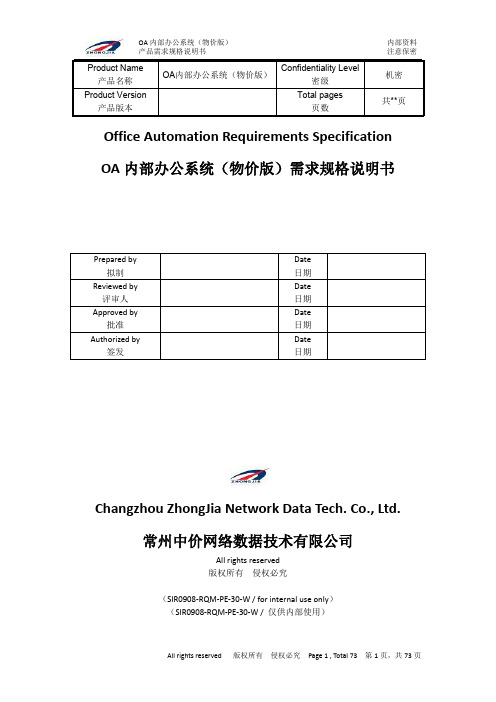
Office Automation Requirements Specification OA内部办公系统(物价版)需求规格说明书Changzhou ZhongJia Network Data Tech. Co., Ltd.常州中价网络数据技术有限公司All rights reserved版权所有侵权必究(SIR0908-RQM-PE-30-W / for internal use only)(SIR0908-RQM-PE-30-W / 仅供内部使用)Revision record 修订记录Distribution List 分发记录Catalog 目录Office Automation Requirements Specification (4)OA内部办公系统(物价版)需求规格说明书 (4)1 Introduction简介 (5)1.1 Purpose目的 (5)1.2 Scope范围 (5)2 General description总体概述 (5)2.1 Software perspective软件概述 (5)2.1.1 About the Project项目介绍 (5)2.1.2 Environment of Product产品环境介绍 (5)2.2 Software function软件功能 (5)2.3 User characteristics用户特征 (5)2.4 Assumptions & Dependencies假设和依赖关系...................... 错误!未定义书签。
3 Specific Requirements具体需求 (6)3.1 Functional Requirements功能需求 (6)3.1.1 GGXX.TZGG.001公共信息模块通知公告功能需求001 (6)1 Introduction概述 (6)2 Resource 数据来源描述 ............................................. 错误!未定义书签。
产品版本管理表格模板
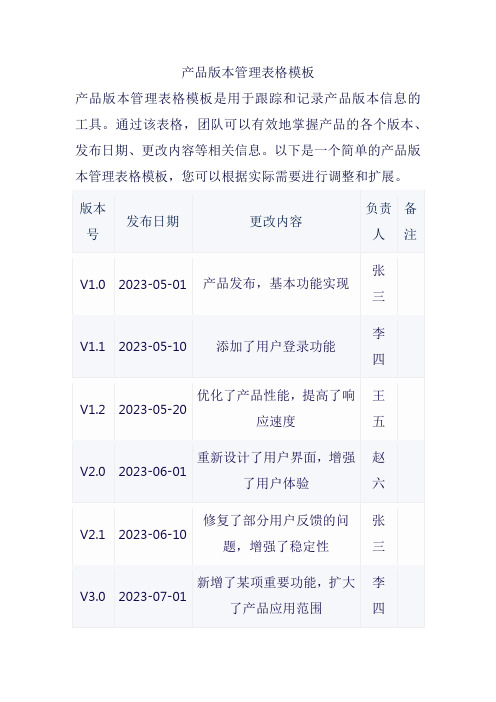
产品版本管理表格模板产品版本管理表格模板是用于跟踪和记录产品版本信息的工具。
通过该表格,团队可以有效地掌握产品的各个版本、发布日期、更改内容等相关信息。
以下是一个简单的产品版本管理表格模板,您可以根据实际需要进行调整和扩展。
在该表格中,我们记录了以下信息:1.版本号:用于标识产品的不同版本。
每个新版本都会分配一个唯一的版本号。
2.发布日期:记录了每个版本的发布时间。
这有助于团队了解各个版本的发布顺序和时间间隔。
3.更改内容:详细列出了每个版本相较于前一版本的更改内容。
这有助于团队成员了解不同版本之间的差异和新增功能。
4.负责人:指负责该版本开发或维护的成员。
这有助于追踪责任人,以便进行后续的版本维护或更新。
5.备注:用于记录与该版本相关的其他信息,如特殊说明、注意事项等。
通过使用这个表格模板,团队可以更好地跟踪和管理产品版本信息。
在开发过程中,团队可以及时了解每个版本的发布情况、更改内容和负责人等信息。
此外,该表格还可以用于评估开发进度、制定计划和协调资源等方面。
需要注意的是,该表格模板只是一个简单的示例,您可以根据实际需要进行调整和扩展。
例如,您可以添加其他列,如测试用例、缺陷修复等,以满足团队的实际需求。
同时,为了确保表格的准确性和完整性,建议定期更新和维护该表格,以确保团队成员可以随时获取最新的版本信息。
总之,产品版本管理表格模板是团队进行产品版本管理的重要工具。
通过使用该表格,团队可以更好地跟踪产品的不同版本、掌握每个版本的发布情况和更改内容等信息。
这对于团队成员之间的协作、开发进度的评估以及资源的协调都具有重要意义。
产品说明书格式范文
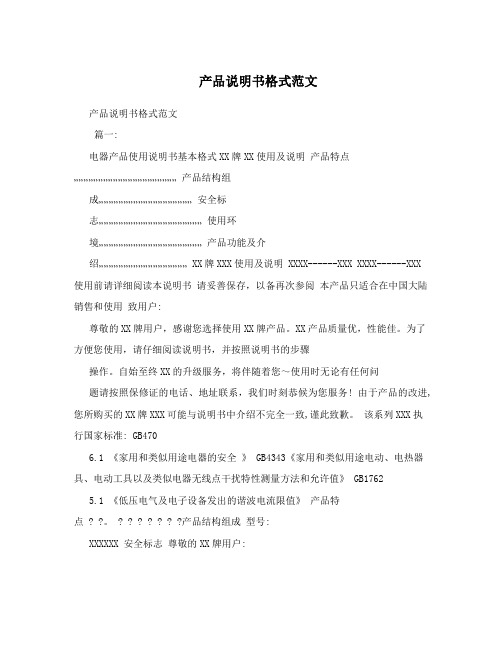
产品说明书格式范文产品说明书格式范文篇一:电器产品使用说明书基本格式XX牌XX使用及说明产品特点……………………………………………………… 产品结构组成………………………………………………… 安全标志……………………………………………………… 使用环境……………………………………………………… 产品功能及介绍……………………………………………… XX牌XXX使用及说明 XXXX------XXX XXXX------XXX 使用前请详细阅读本说明书请妥善保存,以备再次参阅本产品只适合在中国大陆销售和使用致用户:尊敬的XX牌用户,感谢您选择使用XX牌产品。
XX产品质量优,性能佳。
为了方便您使用,请仔细阅读说明书,并按照说明书的步骤操作。
自始至终XX的升级服务,将伴随着您~使用时无论有任何问题请按照保修证的电话、地址联系,我们时刻恭候为您服务! 由于产品的改进,您所购买的XX牌XXX可能与说明书中介绍不完全一致,谨此致歉。
该系列XXX执行国家标准: GB4706.1 《家用和类似用途电器的安全》 GB4343《家用和类似用途电动、电热器具、电动工具以及类似电器无线点干扰特性测量方法和允许值》 GB17625.1 《低压电气及电子设备发出的谐波电流限值》产品特点 ? ?。
? ? ? ? ? ? ?产品结构组成型号:XXXXXX 安全标志尊敬的XX牌用户:您好~感谢你使用本公司产品,为了您能更好地阅读本说明书和使用该产品,以下是我们第一说明书中出现标志符号的解释说明:安全注意事项一、该XXX使用交流220V/50Hz电源能造成该产品烧坏,或异常等故障。
二、警示~电源线插头应保持与插座牢固接触,否则,可能导致火灾。
三、不要损坏电源线1、切勿以拉扯电源线的方法拔出XXX插头。
一定要紧 240V有可紧握住插头,从插座中直接拔出。
2、不要让支撑腿或其它重物品压住电源线或人为踩踏电源线。
3、移动仪器请小心谨慎,切勿滚压或损坏电源线。
产品公告.pdf_1700915024.0752504说明书

Product Announcement:This product is certificated to meet RoHS Directive and Lead-Free produced definition. Using approved critical components only is recommended when the situation to replace defective parts. Vender assumes no liability express or implied, arising out of any unauthorized modification of design or replacing non-RoHS parts. Service providers assume all liability.Qualified Repairability:Proper service and repair is important to the safe, reliable operation of all series products. The service providers recommended by vender should be aware of notices listed in this service manual in order to minimize the risk of personal injury when perform service procedures. Furthermore, the possible existed improper repairing method may damage equipment or products. It is recommended that service engineers should have repairing knowledge, experience, as well as appropriate product training per new model before performing the service procedures.NOTICE:! To avoid electrical shocks, the products should be connected to an authorized power cord, and turn off the master power switch each time before removing the AC power cord.! To prevent the product away from water or expose in extremely high humility environment. ! To ensure the continued reliability of this product, use only original manufacturer’s specified parts.! To ensure following safety repairing behavior, put the replaced part on the components side of PWBA, not solder side.! To ensure using a proper screwdriver, follow the torque and force listed in assembly and disassembly procedures to unscrew screws.! Using Lead-Free solder to well mounted the parts.! The fusion point of Lead-Free solder requested in the degree of 220°C.1. Important Safety Notice2. Exploded view diagram with list of items3. Wiring Connectivity DiagramInterface boardDPUp Down Down Down Downstream stream stream stream streamport port port port portUSB Board (23"&27'': 16:9 1920*1080LED Driver AC INPUT PANELPower BoardHDMI VGAFKKey Board4.1 Disassembly Procedures:Remove the monitor stand base:1. Place the monitor on a soft cloth or cushion.2. Press and hold the stand-release button.3. Lift the stand up and away from the monitor.Use a Philips-head screwdriver to remove 4pcsscrews for unlocking mechanisms. Remove DP cap.(No.1~4 screw size=M4x10; Torque=12±0.5kgfxcm)2323413124Wedge your fingers between the rear cover and the middle bezel on the corners of the top side of the monitor to release the rear cover, then use one hand to press the middle bezel, the other hand to pull up carefully the rear cover in order of arrow preference for unlocking mechanisms of rear cover..Lift the rear cover up carefully. Disconnect the USBFFC cable from the connector of the interface board, and then remove the rear cover.Tear off two pieces of the aluminium foils for unfixing the bracket chassis base .Use a Philips-head screwdriver to remove one screwfor unlocking the USB board unit, then release the USB board unit and put it aside.(No.1 screw size=M3x6, Torque=4±0.5kgfxcm)Unplug the panel power cable from the connector of the panel module, then release the function bytearing the tapes on the back of the cable, and then release the cable from the hooks of the middle bezel.1aluminum foilaluminum foilNecessary repair and test equipment:1. Philips-head screwdriver 2. Hex-head screwdriverTake away the bracket chassis module and then put the bracket chassis module on a protective cushion.Lift up the panel module for releasing the front bezelaway from the panel module.Use a proper tool to release the function key cablefrom the connector, then pull the function key cable high for releasing the function key cable.Use a Philips-head screwdriver to remove 2pcs screws for unlocking the bracket with the panel.Push the earing-lock, and disconnect the LVDS cable from the connector of LCD panel module.(No.1~2 screw size=M3x2.8, Torque=4~5kgfxcm)Use a Philips-head screwdriver to remove 13pcsscrews for unlocking the middle bezel with the unit. (No.1~11 screw size=M3x4, T orque=3~4kgfxcm; No.12~13 screw size=M1.6x1.7, T orque=0.6~1kgfxcm)210411138659721312Take away the .middle bezel then u se a Philips-headscrewdriver to remove 3pcs screws for unlocking the function key board with the middle bezelUse a Hex-head screwdriver to remove two screws for unlocking the D-Sub connector.(No.1~2 screws size=M3x8, Torque=6±0.5kgfxcm) ( No.3~4 screw size=M3x8, Torque=6~7kgfxcm)Use a Philips-head screwdriver to removescrews for unlocking the AC power outlet.twoRemove the interface board and power board from the bracket chassis module carefully, and disconnectall the cables.Remove the Mylar from the hooks of the bracket. Use a Philips-head screwdriver to remove six screws for unlocking the circuit board, release all the cables from the hooks.(No.1~5 screw size=M3x7.5, Torque=6±0.5kgfxcm; No. 6 screw size=M4x8, Torque=6±0.5kgfxcm)346251Take a mylar to insert the hooks of the bracket to cover the power board.Panel preparation: Examine the panel surfaceaccording to inspection criteria. Turn over the panel to place the screen faced down for later assembling.Turn over a power board and put the power boardinto the bracket chassis, locate the panel power cable into the hook of the bracket chassis.Place a bracket chassis base on a protective cushion.Take a interface board, connect a LVDS cable to the connector of the interface board, then connect the cable of the power board to the connector of the interface board. Turn over the interface board andlocate it into the bracket. Use a Philips-head screwdriver to tighten six screws for locking the power board and interface board.(No.1~5 screw size=M3x7.5, Torque=6±0.5kgfxcm; No.6 screw size=M4x8, Torque=6±0.5kgfxcm)34625Put the bracket chassis module on the back of LCDmodule, then lift up the panel with bracket and take1pcs front bezel to assemble with the panel module.1Use a Hex-head screwdriver to tighten two Hex Nutsfor locking the D-Sub connector.(No.1~2 screw size=M3x8, Torque=6±0.5kgfxcm)(No.3~4 screw size=M3x8, Torque=6~7kgfxcm;Use a Philips-head screwdriver to tighten two screws for locking the AC power outlet.2143Connect LVDS cable to the connector of panel. Usea Philips-head screwdriver to tighten 2pcs screws forlocking the bracket with the panel.(No.1~2 screw size=M3x2.8, Torque=4~5kgfxcm)Connect the function key cable to the connector ofthe board. Fix the function key cable with adhesivetapes on the back of the cable.Connect the panel lamp cable to the connector ofthe panel, locate the cable into the hooks of themiddle bezel, then stick 2pcs aluminum foil to fix thebracket chassis base as the picture below shown.aluminum foilTake a function key board and a middle bezel, thenfix the middle bezel with a fixture, and locate thefunction keyboard into the hooks of the bezel Use aPhilips-head screwdriver to tighten 3pcs screws forlocking the function key board with the middle bezel ,then assemble the middle bezel with the front bezel..(No.1~3 screw size=M2x2.4, Torque=0.8±0.2kgfxcmaluminum foil 312Adjust the middle bezel , then use a Philips-headscrewdriver to tighten 13pcs screws for locking themiddle bezel with the assembled unit.(No.1~11 screw size=M3x4, T orque=3~4kgfxcm;No.12~13 screw size=M1.6x1.7, T orque=0.6~1kgfxcm)210411138659721Use a Philips-head screwdriver to tighten 4pcsscrews for locking rear cover with the assembled unit.(No.1~4 screw size=M4x10; Torque=120.5kgfxcm)±Move the assembled rear cover close to the panel unit, then connect the USB FFC cable to the connector of interface board. Put down the rear cover and push the rear cover on the positions marked as the picture below shown formechanisms engagement.Take a USB board, a USB hub and a connect cable. Connect the cable to the USB board, then locate the USB board into the USB hub. Stick 1pcs aluminum foil on one side of the USB hub, then locate the USB unit into the hook of a rear cover. Use a Philips-head screwdriver to tighten one screw for locking the USB unit with the rear cover.(No.1 screw size=M3x6, Torque=4±0.5kgfxcm)2341L video signal to the monitor ift up the monitor, then provide power supply and a, then turn on the monitor for functionality check.Stick 2pcs labels on the specific positions as the picture below shown. Fit the two tabs on the upperpart of the stand into the grooves on the back of the monitor, and then press the stand so that themonitor mounting area snaps onto the stand.15. Trouble Shooting InstructionsWARNING: Before you begin any of the procedures in this section,follow the Safety instructions.Self-testYour monitor provides a self-test feature that allows you to check whether your monitor is functioning properly. If your monitor and computer are properly connected but the monitor screen remains dark, run the monitor self-test by performing the following steps:1.Turn off both your computer and the monitor.2.Unplug the video cable from the back of the computer.3.Turn on the monitor.The floating dialog box should appear on-screen (against a black background), if the monitor cannot sense a video signal and is working correctly. While in self-test mode, the power LED remains white. Also, depending upon the selected input, one of the dialogs shown below will continuously scroll through the screen.oror4.This box also appears during normal system operation, if the video cablebecomes disconnected or damaged.5.Turn Off your monitor and reconnect the video cable; then turn On both yourcomputer and the monitor.If your monitor screen remains blank after you use the previous procedure, check your video controller and computer, because your monitor is functioning properly.Built-in diagnosticsYour monitor has a built-in diagnostic tool that helps you determine if the screen abnormality you are experiencing is an inherent problem with your monitor, or with your computer and video card.NOTE: You can run the built-in diagnostics only when the video cable isunplugged and the monitor is in self-test mode.To run the built-in diagnostics:1.Ensure that the screen is clean (no dust particles on the surface of thescreen).2.Unplug the video cable(s) from the back of the computer or monitor. Themonitor then goes into the self-test mode.3.Press and hold Button 1 on the front panel for 5 seconds. A gray screenappears.4.Carefully inspect the screen for abnormalities.5.Press Button 1 on the front panel again. The color of the screen changes tored.6.Inspect the display for any abnormalities.7.Repeat steps 5 and 6 to inspect the display in green, blue, black, white, andtext screens.The test is complete when the text screen appears. To exit, press Button 1 again. If you do not detect any screen abnormalities upon using the built-in diagnostic tool, the monitor is functioning properly. Check the video card and computer.No Video/Power LED on No picture or nobrightness•Increase brightness & contrastcontrols via OSD.•Perform monitor self-test featurecheck.•Check for bent or broken pins in thevideo cable connector.•Run the built-in diagnostics.•Ensure that the corr ect input source isselected in the Input Source menu.Poor Focus Picture is fuzzy,blurry, or ghosting •Perform Auto Adjust via OSD.•Adjust the Phase and Pixel Clock controls via OSD.•Eliminate video extension cables.•Reset the monitor to factory settings.•Change the video resolution to the correct aspect ratio.Shaky/Jittery Video Wavy picture orfine movement•Perform Auto Adjust via OSD.•Adjust the Phase and Pixel Clockcontrols via OSD.•Reset the monitor to factory settings.•Check environmental factors.•Relocate the monitor and test inanother room.Missing Pixels LCD screen hasspots •Cycle p ower O n-Off.•Pixel that is permanently Off is a natural defect that can occur in LCD technology.•For more information on Dell Monitor Quality and Pixel Policy, see DellSupport site at: http:///support/monitors.Common problemsThe following table contains general information about common monitor problems you might encounter and the possible solutions:Common symptomsWhat youexperiencePossible solutionsNo Video/Power LED off No picture•Ensure that the video cableconnecting the monitor and thecomputer is properly connected andsecure.•Verify that the power outlet isfunctioning properly using any otherelectrical equipment.•Ensure that the power button ispressed fully.•Ensure that the corr ect input source isselected in the Input Source menu.Stuck-on Pixels LCD screen hasbright spots •Cycle p ower On-Off.•Pixel that is permanently off is a natural defect that can occur in LCD technology.•For more information on Dell Monitor Quality and Pixel Policy, see DellSupport site at: http:///support/monitors.Brightness Problems Picture too dim ortoo bright•Reset the monitor to factory settings.•Perform Auto Adjust via OSD.•Adjust brightness & contrast controlsvia OSD.Geometric Distortion Screen notcentered correctly•Reset the monitor to factory settings.•Perform Auto Adjust via OSD.•Adjust horizontal & vertical controlsvia OSD.•When using HDMI/DisplayPort input,the positioning adjustments are notavailable.Horizontal/ Vertical Lines Screen has one ormore lines•Reset the monitor to factory settings.•Perform Auto Adjust via OSD.•Adjust the Phase and Pixel Clockcontrols via OSD.•Perform monitor self-test featurecheck and determine if these lines arealso in self-test mode.•Check for bent or broken pins in thevideo cable connector.•Run the built-in diagnostics.•When using HDMI/DisplayPort input,the Pixel Clock and Phaseadjustments are not available.Synchronization Problems Screen isscrambled orappears torn•Reset the monitor to factory settings.•Perform Auto Adjust via OSD.•Adjust the Phase and Pixel Clockcontrols via OSD.•Perform monitor self-test featurecheck to determine if the scrambledscreen appears in self-test mode.•Check for bent or broken pins in thevideo cable connector.•Restart the computer in the safemode.Safety Related Issues Visible signs ofsmoke or sparks•Do not perform any troubleshootingsteps.•Contact D e ll i mmediately.Intermittent Problems Monitormalfunctions on &off•Ensure that the video cableconnecting the monitor to thecomputer is connected properly and issecure.•Reset the monitor to factory settings.•Perform monitor self-test featurecheck to determine if the intermittentproblem occurs in self-test mode.Missing Color Picture missingcolor •Perform monitor self-test feature check.•Ensure that the video cableconnecting the monitor to thecomputer is connected properly and is secure.•Check for bent or broken pins in the video cable connector.Product specific problemsCommon symptomsWhat youexperiencePossible solutionsScreen image is too small Image is centeredon screen, butdoes not fill entireviewing area•Check t he Aspect Ratio setting in theDisplay menu OSD.•Reset the monitor to factory settings.No Input Signal when user controls are pressed No picture, theLED light is white•Check the signal source. Ensure thecomputer is not in the power savingmode by moving the mouse or pressingany key on the keyboard.•Check whether the signal cable isplugged in properly. Re-plug the signalcable if necessary.•Reset the computer or video player.Wrong Color Picture color notgood •Change the settings of the Preset Modes in the Color menu OSDdepending on the application.•Adjust R/G/B value under Custom Color in Color menu OSD.•Run the built-in diagnostics.Image retention from a static image left on the monitor for a long period of time Faint shadowfrom the staticimage displayedappears on thescreen••Alternatively, use a dynamicallychanging screensaver.Set the screen to turn o after a fewminutes of screen idle time. These canbe adjusted in Windows Power Optionsor Mac Energy Saver setting.The picture does not fill the entire screen The picture cannotfill the height orwidth of the screen•Due to different video formats (aspectratio) of DVDs, the monitor may displayin full screen.•Run the built-in diagnostics.NOTE: When choosing HDMI/DisplayPort mode, the Auto Adjustfunction will not be available.Universal Serial Bus (USB) specific problemsCommon symptomsWhat youexperiencePossible solutionsUSB interface is not working USB peripheralsare not working•Check that your monitor is turned On.•Reconnect the upstream cable to yourcomputer.•Reconnect the USB peripherals(downstream connector).•Switch Off and then turn On themonitor again.•Reboot the computer.•Some USB devices like externalportable HDD require higher electriccurrent; connect the device directly tothe computer system.Super Speed USB 3.0 interface is slow Super Speed USB3.0 peripheralsworking slowly ornot working at all•Check that your computer is USB 3.0-capable.•Some computers have USB 3.0, USB2.0, and USB 1.1 ports. Ensure that thecorrect USB port is used.•Reconnect the upstream cable to yourcomputer.•Reconnect the USB peripherals(downstream connector).•Reboot the computer.Wireless USB peripherals stop working when a USB 3.0 device is plugged in Wireless USBperipheralsresponding slowlyor only working asthe distancebetween itself andits receiverdecreases•Increase the distance between theUSB 3.0 peripherals and the wirelessUSB receiver.•Position your wireless USB receiver asclose as possible to the wireless USBperipherals.•Use a USB-extender cable to positionthe wireless USB receiver as far awayas possible from the USB 3.0 port.。
版本计划模板
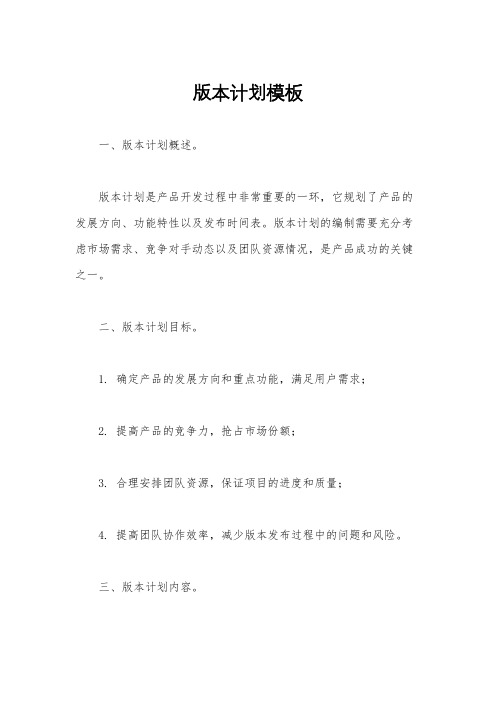
版本计划模板一、版本计划概述。
版本计划是产品开发过程中非常重要的一环,它规划了产品的发展方向、功能特性以及发布时间表。
版本计划的编制需要充分考虑市场需求、竞争对手动态以及团队资源情况,是产品成功的关键之一。
二、版本计划目标。
1. 确定产品的发展方向和重点功能,满足用户需求;2. 提高产品的竞争力,抢占市场份额;3. 合理安排团队资源,保证项目的进度和质量;4. 提高团队协作效率,减少版本发布过程中的问题和风险。
三、版本计划内容。
1. 产品需求分析。
1.1 收集用户反馈和市场调研数据,明确用户需求和行业趋势;1.2 对产品功能进行评估和优化,确定下一个版本的核心功能和改进点。
2. 技术可行性分析。
2.1 技术团队评估当前产品技术架构和现有功能,确定新功能的技术实现方案;2.2 确定新功能对现有系统的影响和改动,评估开发周期和资源投入。
3. 版本规划。
3.1 确定版本发布的时间节点,合理安排版本开发、测试和上线时间;3.2 制定版本发布的功能点和优先级,明确每个功能的开发周期和责任人。
4. 资源调配。
4.1 根据版本计划确定团队资源需求,合理分配开发、测试和运维人员;4.2 评估团队资源的稳定性和可用性,确保团队成员的技能和经验能够支撑版本计划的实施。
5. 风险评估。
5.1 分析版本计划执行过程中可能出现的风险和问题,制定相应的预案和解决方案;5.2 定期跟踪版本计划的执行情况,及时调整和优化计划,确保版本发布的顺利进行。
四、版本计划编制流程。
1. 收集需求,与产品经理、市场团队、用户进行沟通,明确用户需求和市场趋势;2. 技术评估,技术团队评估新功能的技术难点和实现方案;3. 制定计划,根据需求和技术评估结果,制定版本计划的时间表和功能点;4. 资源调配,根据版本计划确定团队资源需求,合理分配开发、测试和运维人员;5. 风险评估,分析版本计划执行中可能出现的风险和问题,制定相应的预案和解决方案;6. 定期跟踪,跟踪版本计划的执行情况,及时调整和优化计划,确保版本发布的顺利进行。
- 1、下载文档前请自行甄别文档内容的完整性,平台不提供额外的编辑、内容补充、找答案等附加服务。
- 2、"仅部分预览"的文档,不可在线预览部分如存在完整性等问题,可反馈申请退款(可完整预览的文档不适用该条件!)。
- 3、如文档侵犯您的权益,请联系客服反馈,我们会尽快为您处理(人工客服工作时间:9:00-18:30)。
产品版本发布说明书
软件版本发布说明书
软件系统全称及英文全称
软件系统简称及英文简称
版本发布申请人
本次版本发布类型
□ 对内发布(发布给公司内部进行内部系统或回归测试。)
□ 对外发布(发布给市场、或客户使用)
基础版本(内部版本号)
发布时间
本次发布版本(内部版本号)
发布时间
外部版本(对外发布的版本号,与内部版本无关但是对应,一般由市场部来定义)
发布时间
新增功能说明
序号
功能需求编号
功能名称
描述
**是否通过测试
修复缺陷说明
序号
缺陷号
所属功能模块(或编号)
缺陷简要描述
**是否修正
安装手册(或系统部署维护手册)附件
[给出附件的正确名称,并指明在SVN中放置的具体地点]
**测试报告附件
(包含缺陷分析报告)
[给出附件的正确名称,并指明在SVN中放置的具体地点]
□测试通过
□测试基本通过,但是还需改进这些地方:
□测试不通过
负责人签字/日期:
**本项目直接负责上级(具体意见、签字、日期):
上级领导根据上面提交的所有附件的完备性,以及配置管理负责人和测试负责人的签署意见,给出最后的审批意见。
□同意版本发布(上述要求都满足,所以满足版本发布要求)
□同意版本紧急发布(虽然上述要求不满足,但是因为市场要求或别的更重要的原因,必须紧急发布新的版本。需要承担一定的质量风险)
**版本发布审批
**公司配置管理负责人(具体意见、签字、日期):
参考该项目的《配置项最低提交物审计报告》,见上面应提交的附件信息,给出下面的审批结论:
□满足最低提交物要求
□不满足最体提交要求,还缺少这些文档:
负责人签字/日期:
**公司测试负责人(具体意见、签字、日期):
参考该项目的《测试报告》,见上面应提交的附件信息,给出下面的审批结论:
注:如果质量组没有参与该项目的系统测试,必须在此说明项目组出具的交叉测试报告(及缺陷分析报告,可以含在交叉测试报告当中);如果质量组有参与该项目的系统测试,必须在此说明质量组出具的系统测试报告(及缺陷分析报告,可以含在系统测试报告当中)。
配置项最低提交物审计报告
[给出附件的正确名称,并指明:
注:如果在“本次版本发布类型”选择了“对外发布”版本,则标记了“**”的输入项必须由有关负责人进行录入和签署;其他所有项都为必填项,所以不再用另外的标记注明。
